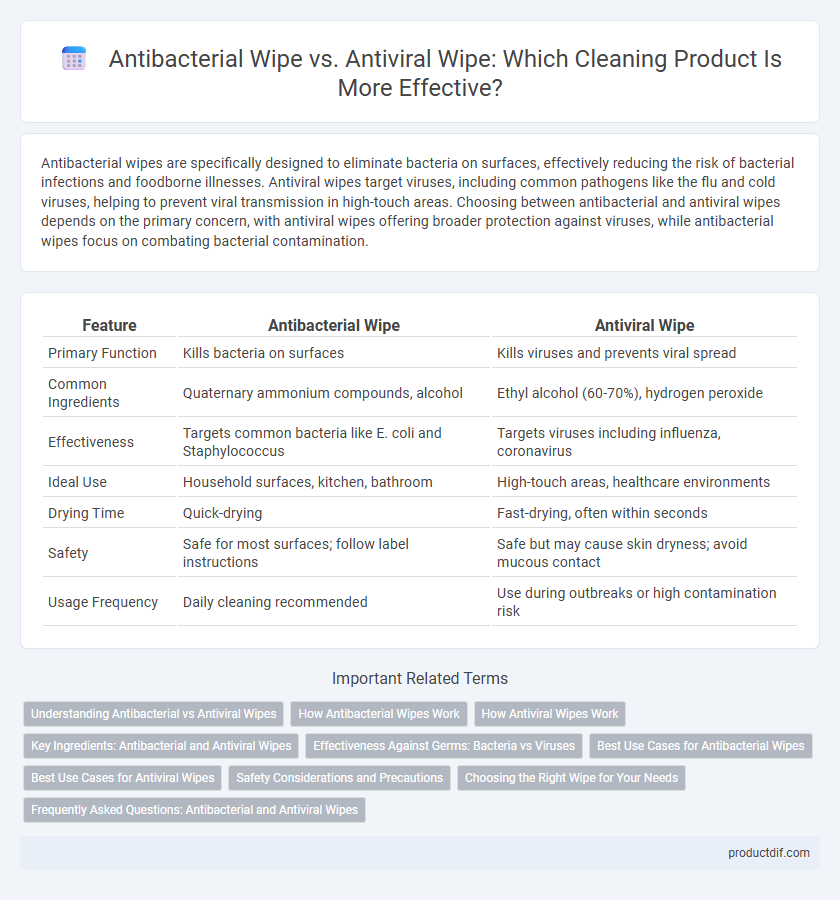Antibacterial wipes are specifically designed to eliminate bacteria on surfaces, effectively reducing the risk of bacterial infections and foodborne illnesses. Antiviral wipes target viruses, including common pathogens like the flu and cold viruses, helping to prevent viral transmission in high-touch areas. Choosing between antibacterial and antiviral wipes depends on the primary concern, with antiviral wipes offering broader protection against viruses, while antibacterial wipes focus on combating bacterial contamination.
Table of Comparison
| Feature | Antibacterial Wipe | Antiviral Wipe |
|---|---|---|
| Primary Function | Kills bacteria on surfaces | Kills viruses and prevents viral spread |
| Common Ingredients | Quaternary ammonium compounds, alcohol | Ethyl alcohol (60-70%), hydrogen peroxide |
| Effectiveness | Targets common bacteria like E. coli and Staphylococcus | Targets viruses including influenza, coronavirus |
| Ideal Use | Household surfaces, kitchen, bathroom | High-touch areas, healthcare environments |
| Drying Time | Quick-drying | Fast-drying, often within seconds |
| Safety | Safe for most surfaces; follow label instructions | Safe but may cause skin dryness; avoid mucous contact |
| Usage Frequency | Daily cleaning recommended | Use during outbreaks or high contamination risk |
Understanding Antibacterial vs Antiviral Wipes
Antibacterial wipes target and eliminate bacteria, preventing infections and inhibiting bacterial growth on surfaces, while antiviral wipes specifically deactivate viruses, reducing the risk of viral transmission. Both types of wipes contain active ingredients tailored to their purpose, such as benzalkonium chloride for antibacterial action and ethanol or hydrogen peroxide for antiviral effectiveness. Choosing the appropriate wipe depends on the specific microbial threat and the intended use environment, ensuring optimal hygiene and safety.
How Antibacterial Wipes Work
Antibacterial wipes work by using chemical agents like alcohol, benzalkonium chloride, or triclosan to disrupt and kill bacteria on surfaces, preventing the spread of infections. These wipes target bacterial cell walls and proteins, effectively eliminating common pathogens such as Staphylococcus aureus and Escherichia coli. Unlike antiviral wipes, antibacterial wipes are specifically designed to reduce bacterial contamination but may not be effective against viruses like influenza or coronavirus.
How Antiviral Wipes Work
Antiviral wipes work by containing active ingredients such as alcohol, quaternary ammonium compounds, or hydrogen peroxide that disrupt the lipid envelope or protein coat of viruses, effectively inactivating them on surfaces. These wipes target specific viral structures, preventing viruses from binding to host cells and replicating, thereby reducing the risk of infection transmission. Compared to antibacterial wipes that focus on killing bacteria, antiviral wipes are formulated to neutralize a broader range of pathogens, including influenza, coronavirus, and other viruses.
Key Ingredients: Antibacterial and Antiviral Wipes
Antibacterial wipes primarily contain ingredients like benzalkonium chloride or triclosan that target and eliminate bacteria on surfaces. Antiviral wipes are formulated with agents such as ethanol or hydrogen peroxide, designed to effectively neutralize viruses including influenza and coronaviruses. Selecting the appropriate wipe depends on the specific microbial threat and the active compounds proven to disrupt those pathogens.
Effectiveness Against Germs: Bacteria vs Viruses
Antibacterial wipes target and eliminate bacteria on surfaces, using agents like benzalkonium chloride to disrupt bacterial cell membranes, making them effective against common germs such as E. coli and Staphylococcus aureus. Antiviral wipes contain ingredients like alcohol or hydrogen peroxide that inactivate viruses by breaking down their protein coats and RNA, providing protection against pathogens like influenza and coronaviruses. Selecting between antibacterial and antiviral wipes depends on the specific germ type being addressed, with antiviral wipes offering broader efficacy against viruses that antibacterial wipes may not effectively neutralize.
Best Use Cases for Antibacterial Wipes
Antibacterial wipes are most effective for killing bacteria on surfaces commonly touched, such as countertops, door handles, and kitchen appliances, preventing bacterial infections and cross-contamination. These wipes are ideal for everyday household cleaning, particularly in areas prone to food preparation and personal hygiene. For viral contamination, antiviral wipes should be used instead, but antibacterial wipes remain essential for targeting harmful bacteria in daily sanitation routines.
Best Use Cases for Antiviral Wipes
Antiviral wipes are specifically formulated to neutralize a broad spectrum of viruses, including influenza, coronavirus, and other respiratory pathogens, making them ideal for high-contact surfaces in healthcare settings, public transportation, and schools. Their fast-acting antiviral agents help reduce viral transmission more effectively than standard antibacterial wipes, which primarily target bacteria and some fungi. Using antiviral wipes on smartphones, doorknobs, and keyboards supports comprehensive infection control, particularly during viral outbreaks or flu season.
Safety Considerations and Precautions
Antibacterial wipes target bacteria, effectively reducing germs on surfaces, but may not eliminate viruses, requiring careful selection for viral protection. Antiviral wipes contain ingredients designed to inactivate viruses, offering enhanced safety during outbreaks of viral illnesses. Both types should be used according to manufacturer instructions, avoiding skin contact and ensuring proper ventilation to minimize chemical exposure risks.
Choosing the Right Wipe for Your Needs
Antibacterial wipes target bacteria by eliminating germs that cause common infections, making them ideal for everyday cleaning on surfaces like kitchen counters and bathroom fixtures. Antiviral wipes are specifically formulated to deactivate viruses, including influenza and coronaviruses, providing enhanced protection in high-risk areas such as healthcare settings and public spaces. Selecting the right wipe depends on identifying whether your priority is combating bacterial contamination or preventing viral transmission to ensure effective hygiene maintenance.
Frequently Asked Questions: Antibacterial and Antiviral Wipes
Antibacterial wipes target and eliminate bacteria on surfaces, reducing the risk of infections caused by bacterial pathogens, while antiviral wipes specifically neutralize viruses such as influenza and coronaviruses to prevent viral transmission. These wipes often contain active ingredients like benzalkonium chloride for antibacterial action and ethanol or hydrogen peroxide for antiviral effectiveness. Choosing the right wipe depends on the desired protection, with antibacterial wipes suited for everyday germ control and antiviral wipes essential in environments with viral outbreak concerns.
Antibacterial Wipe vs Antiviral Wipe Infographic

 productdif.com
productdif.com